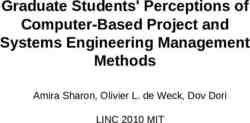A Condensed Crash Course on C++ ECE 417/617: Elements of
69 Slides281.50 KB

A Condensed Crash Course on C ECE 417/617: Elements of Software Engineering Stan Birchfield Clemson University

Recommended C resources Bjarne Stroustrup, The C Programming Language Scott Meyers, Effective C

Why C ? Popular and relevant (used in nearly every application domain): – end-user applications (Word, Excel, PowerPoint, Photoshop, Acrobat, Quicken, games) – operating systems (Windows 9x, NT, XP; IBM’s K42; some Apple OS X) – large-scale web servers/apps (Amazon, Google) – central database control (Israel’s census bureau; Amadeus; MorganStanley financial modeling) – communications (Alcatel; Nokia; 800 telephone numbers; major transmission nodes in Germany and France) – numerical computation / graphics (Maya) – device drivers under real-time constraints Stable, compatible, scalable

C vs. C C is C incremented (orig., “C with classes”) C is more expressive (fewer C source lines needed than C source lines for same program) C is just as permissive (anything you can do in C can also be done in C ) C can be just as efficient (most C expressions need no run-time support; C allows you to – manipulate bits directly and interface with hardware without regard for safety or ease of comprehension, BUT – hide these details behind a safe, clean, elegant interface) C is more maintainable (1000 lines of code – even brute force, spaghetti code will work; 100,000 lines of code – need good structure, or new errors will be introduced as quickly as old errors are removed)

Efficiency and Maintainability ity l i b a n e) ta i Main mmer tim ra (prog cy n e i c i e) m Eff i t r e sso c o r p ( 90/10 rule: 10% of your program will take 90% of the processor time to run optimize what needs to be optimized, but no more focus on design

Design goals of C Backward compatibility with C (almost completely – every program in K&R is a C program – but additional keywords can cause problems) Simplicity, elegance (few built-in data types, e.g., no matrices) Support for user-defined data types (act like built-in types; N.B. Standard Template Library (STL)) No compromise in efficiency, run-time or memory (unless “advanced features” used) Compilation analysis to prevent accidental corruption of data (type-checking and data hiding) Support object-oriented style of programming

Compatibility with C How is C not backward compatible with C (C89)? C does not allow Other differences: old-style C function declarations const global variables have void f(a) int a; {} internal linkage in C , external in C generic function declarations extra keywords in C void f(); void g() { f(2); } void main() { int catch 5; } setting enum to int enum Dir {Up, Down}; Dir bizarre comments d 1; int f(int a, int b) { multiple declarations return a//**/b int i; int i; ; assigning to void * } int* p malloc(10); “implicit int” (For these, C is backward signed a 7; compatible with C99)

Purpose of a programming language Programming languages serve two purposes: – vehicle for specifying actions to be executed “close to the machine” – set of concepts for thinking about what can be done “close to the problem being solved” Object-oriented C excels at both

Learning C Goal: Don’t just learn new syntax, but become a better programmer and designer; learn new and better ways of building systems Be willing to learn C ’s style; don’t force another style into it C supports gradual learning – Use what you know – As you learn new features and techniques, add those tools to your toolbox C supports variety of programming paradigms

Programming paradigms procedural – implement algorithms via functions (variables, functions, etc.) modular – partition program into modules (separate compilation) object-oriented – divide problem into classes (data hiding, inheritance) abstract – separate interface from implementation (abstract classes) generic – manipulate arbitrary data types (STL: containers, algorithms)

What is object-oriented? Encapsulation “black box” – internal data hidden Inheritance SDC related classes share implementation and/or interface Polymorphism ability to use a class without knowing its type “C is an object-oriented language” C provides mechanisms that support object-oriented style of programming

Some C concepts constructor / destructor / copy constructor initialization list inheritance exceptions overloading operators (e.g., assignment operator) namespace const virtual function pure virtual (abstract) function friend template standard template library (STL) pass by value, pass by reference composition versus derivation

A simple C program #include iostream // std::cout #include cstdio // printf int main() { int a 5; // 'a' is L-value float b 0.9f; printf("Hello world %d %3.1f \n", a, b); std::cout "Hello world" a " " b " " std::endl; return 0; }

Declarations and definitions Declaration: – extern char c; – struct User; – double sqrt(double); Okay to have many Definition: – char c; – int count 1; – double abs(double a) { a 0 ? a : -a; } Must have exactly one

Fundamental types bool (true 1, false 0) char (could be signed or unsigned INTEGRAL – implementation-defined) int (signed by default) ARITHMETIC double void (“pseudo-type”) enum USER-DEFINED class also short, long, struct, float, wchar t, etc.) Do not rely on sizes of these! (Implementation-dependent)

Macros Dangerous: – compiler never sees them source code translation unit – global Instead, use – – – – const inline template enum Example: template typename T inline T max(T t){ t 0 ? t : -t; } Ok to use for include guards (“header wrappers”) If you must use a macro, give it a long ugly name with lots of capital letters

Memory allocation “on the stack” – block delimited by {} – object alive till it falls out of scope – calls constructor / destructor “on the heap” – – – – – new and delete replace malloc, calloc, free object exists independently of scope in which it was created also “on the free store” or “allocated in dynamic memory” be careful: new delete, new[] delete[] for safety, same object should both allocate and deallocate “local static store” void foo() { static int i 0; }

Global variables Built-in types initialized to 0 (but local variables uninitialized) Initialized before main() invoked Initialization order: – within translation unit, same as definition – between translation units, arbitrary order Bad! No guarantee that twopi will be initialized correctly file1.cpp file2.cpp double pi 3.14; double twopi 2*pi;

A class class Date { public: enum Month {Jan, Feb, Mar, .} Date(int year, Month month, int day); member int GetDay() const; functions void SetDay(int day); (methods) Date& operator (int days); private: member Month m month; variables int m year, m day; };

Struct vs. class In C , no difference b/w struct and class (except default public vs. private) In C , struct can have – – – – – member variables methods public, private, and protected virtual functions etc. Rule of thumb: – Use struct when member variables are public (just a container) – Use class otherwise

OO in C In C, a struct can have both member variables and methods: void CreateFoo() { } struct Foo { void (*Construct)(); int m data; }; int main() { struct Foo a; a.Construct &CreateFoo; a.Construct(); } In C , syntax is simpler: struct Foo { Foo() int m data; }; Foo::Foo() { } int main() { Foo a; }

Names Maintain consistent naming style – long names for large scope – short names for small scope Don’t start with underscore; reserved for special facilities Avoid similar-looking names: l and 1 Choosing good names is an art

Access control Public: visible to everyone Private: visible only to the implementer of this particular class Protected: visible to this class and derived classes Good rule of thumb: – member functions (methods): if non-virtual, then public or protected if virtual, then private – member variables should be private (except in the case of a struct)

The big four By default, each class has four methods: – constructor Date(); – destructor Date(); – copy constructor Date(const Date& other); – assignment operator Date& operator (const Date& other); These call the appropriate functions on each member variable Be careful: If this is not what you want, then either override or disallow (by making private)

Constructor and destructor (Copy) constructor creates object Destructor destroys (“cleans up”) object Be aware of temporary objects class Matrix { Matrix(const Matrix& other); Matrix operator (const Matrix& other) const; Matrix& operator (const Matrix& other); }; void foo() { Matrix a, b, c, d; a b c d; } What functions get called? (Note: There are ways to speed this up while preserving the syntax)

Example Suppose we have a simple class. class A { public: A() A(const A& other) A() A& operator (const A& other) { { { { } }; printf("con\n"); } printf("copycon\n"); } printf("des\n"); } printf("assign\n"); return *this;

Example 1 What is the output of the following program? 01 { 02 03 04 05 06 07 } A a; A* b new A(); *b a; delete b; A c a; 02 03 04 05 06 07 07 con con assign des copycon des des

Example 2 What is the output of the following program? 01 void F(const A& f, A* g, A h) 02 { 03 *g f; 04 } 05 { 06 07 08 } A a, b; F( a, &b, a); 06 06 01 03 04 08 08 con con copycon assign des des des

Example 3 What is the output of the following program? 01 A F() 02 { 03 04 05 } 06 { 07 08 } A tmp; return tmp; A a F(); (VC 6.0 -- Windows) 03 con 07 copycon 05 des 08 des (g 3.4.3 -- Linux) 07 con 08 des

Avoid new and delete Whenever possible, avoid ‘new’ and ‘delete’ Instead create object on stack Automatic destructor makes things easier No need to worry about forgetting to delete the object (memory leak) or deleting the wrong object (crash) If you must use ‘new’, then try to keep the ‘delete’ nearby This helps code maintenance – otherwise it is hard to keep track of the new/delete pairs

When to use new and delete Sometimes you have to use new and delete And sometimes the pair cannot be close together Oh well The next slide shows an example where we need to break both of these rules

An example of new/delete You have a base class: class Command { virtual DoSomething(); }; You have several derived classes: class CommandAdd : public Command {}; class CommandMove : public Command {}; class CommandSet : public Command {}; You have a list of objects whose types are unknown at compile time (polymorphism): std::vector Command* undo list; Must put pointers in list – not actual objects – because the objects may be of different sizes (among other reasons) Someone creates the object and puts its pointer on the list: undo list.push back( new CommandAdd() ); Later the object is removed from the list and deleted: Command* com undo list.back(); undo list.pop(); com- DoSomething(); // call a virtual method delete com;

Initializer lists Assign values inside constructor: Matrix::Matrix(const Matrix& other) { m n 0; m a 0; } Use initializer list: Matrix::Matrix(const Matrix& other) : m n(0), m a(0) { }

Concrete classes A concrete class – does a single, relatively small thing well and efficiently – hides data members (encapsulation) – provides clean interface – acts like a built-in type – is a “foundation of elegant programming” – Stroustrup Don’t underestimate the importance of this basic C /OO feature!

Class relationships OK: – A calls function from B – A creates B – A has a data member of type B Bad: – A uses data directly from B (without using B’s interface) Even worse: – A directly manipulates data in B

Pointers, arrays, references Use 0, not NULL (stronger type checking) Name of array is equivalent to pointer to initial element Access array using * or []; same efficiency with modern compiler use std::vector, not built-in array, when possible Reference is like a pointer

References Reference: alternate name for an object (alias) There is no null reference No reference to a temporary Syntax confusing Basically a const dereferenced pointer with no operations int b; int &a b; int &a; (Now use ‘a’ as ‘b’) int& a 1; int* c &a; “get address of” (not a reference)

Confusing syntax int a, b; int c a * b; int* d &a; int e *d; int& f a; * means multiplication, or pointer, or dereference pointer & means get address of, or reference Same symbol, different meanings!

pass by value pass by pointer Pass by X pass by reference void f(int a, int* b, int& c) { // changes to a are NOT reflected outside the function // changes to b and c ARE reflected outside the function } DOES make a copy main() { int a, b, c; f(a, &b, c); does NOT make a copy } PBP and PBR are different syntax for the same functionality

Argument passing / return Pass / return by value – calls copy constructor – ok for built-in types int foo(int a) { return 0; } – performance penalty for structs and classes (temporary objects) Pass / return by reference or pointer – does not call copy constructor – pass inputs by const reference – never pass inputs by “plain” reference void update(int& a); update(2); // error – pass outputs by pointer int x 1; next(x); // should not change x int x 1; next(&x); // may change x – ok to return a ref, or const ref

C function mechanisms Overloaded function names – Cleaner and safer print(int); print(float); – But beware print(int); print(int*); print(0); Default parameters void print(int a, int b 0, int c 0); Operator overloading Matrix& operator (const Matrix& other); Implicit conversion operator operator int() const {} // converts to int – Provides convenient syntax, but potentially dangerous so use sparingly

Opaque pointers An opaque pointer is used to hide the internal implementation of a datatype Also called Pimpl (pointer to implementation) idiom, or Cheshire Cat Example: The d-pointer is the only private data member of the class and points to an instance of a struct defined in the class' implementation file http://en.wikipedia.org/wiki/Opaque pointer

Explicit type conversion C casts – static cast between 2 related types (int/float, int/enum, 2 pointers in class hierarchy) – reinterpret cast between 2 unrelated types (int/ptr, pointers to 2 unrelated classes) – const cast cast away constness – dynamic cast used for polymorphic types Run-time type info (RTTI) Avoid casts, but use these instead of C casts – e.g., compiler can perform minimal checking for static cast, none for reinterpret cast

Namespaces Namespace expresses logical grouping using declaration – Don’t use global using except for transition to older code – Ok in namespace for composition – Ok in function for notational convenience Namespaces are open Unnamed namespaces restrict code to local translation unit Aliases ( namespace ShortName LongName; )

Const Const prevents object from being modified (orig., readonly) Avoid magic numbers char a[128]; const int maxn 128; char a[maxn]; Logical constness vs. physical constness Const is your friend; use it extensively and consistently can cast away constness, but be sure to use mutable const pointers: – – – – – const int * const ptr &a[0]; // const ptr to a const int int const * const ptr &a[0]; // ” int * const p2 &a[0]; // const ptr to an int const int * p1 &a[0]; // ptr to a const int int const * p2 &a[0]; // ”

Assert macro Assert allows the programmer to explicitly type assumptions about expected inputs and values Use assert generously; it is your friend Assert helps to catch bugs early during development Assert is removed by precompiler before final release, so no runtime penalty Use assert only to check values; do not change values!!! #include assert.h int GetValue(int index) { assert(index 0 && index array.size()); if (index 0 index array.size()) return -1; // value should make sense return array[index]; } If performance is not a concern, then it is okay to augment (but not to replace) assert with an extra check that will remain in the final version.

Inheritance Subclass derived from base class Two classes should pass the “ISA” test: derived class is a base class class Shape { }; class Circle : public Shape { }; Class hierarchy: means of building classes incrementally, using building blocks (subclass becomes base class for someone else) Facilitates code reuse

Inheritance vs. composition Inheritance: “is a” class Circle : public Shape { }; Composition: “has a” class Circle { private: Shape m shape; }; Decision should be based on commonality of interface

Virtual functions Function of derived class is called even if you have only a pointer to the base class File.h File.cpp class Shape { virtual void Draw(); }; void Func1() { Circle mycirc; Func2(&mycirc); } class Circle : public Shape { virtual void Draw(); }; void Func2(Shape* s) { s- Draw(); // calls Circle::Draw() }

How a virtual function works Shape vtable Circle vtable vfunc1 addr vfunc1 addr vfunc2 addr vfunc2 addr . . vfuncN addr vfuncN addr { shape member variables circle member variables { mycirc var1 . varM vtable ptr var1 . varN

What is the penalty of a virtual function? Space: – one vtable per class with virtual function(s) – one pointer per instance Time: – one extra dereference if type not known at compile time – no penalty if type known at compile time (ok to inline a virtual function)

Pure virtual function Pure virtual function – Function intentionally undefined – Same penalty as regular virtual function Abstract class class Shape { virtual void Draw() 0; }; – Contains at least one pure virtual function – Cannot instantiate; must derive from base class and override pure virtual function – Provides an interface (separates interface from implementation) Advice: virtual functions should always be pure virtual – i.e., “Make non-leaf classes abstract” (Scott Meyers, Item 29) – Also, “Don’t derive from concrete classes” (Herb Sutter, p. 137) More advice: Make virtual functions private (Herb Sutter, p. 134). This separates the override implementation details from the public interface.

Multiple inheritance C allows you to inherit from multiple base classes Works best if – exactly one base class passes ISA test – all other base classes are interfaces Advanced feature that is rarely needed class MyDialog : public CDialog, Observer {}; MyDialog is a CDialog MyDialog needs a single method from Observer (lightweight class) (see MVC architecture)

Polymorphism Polymorphism – “ability to assume different forms” – one object acts like many different types of objects (e.g., Shape*) – getting the right behavior without knowing the type – manipulate objects with a common set of operations Two types: – Run-time (Virtual functions) – Compile-time (Templates)

Exceptions Error handling in C: – Half of code is error handling – Dangerous: Easy for programmer to forget to check return value void Func() { int ret; ret OpenDevice(); if (ret ! 0) error(“Unable to open device”); ret SetParams(); if (ret ! 0) error(“Unable to set params”); }

Exceptions (cont.) Error handling in C : – try-catch blocks safer – separate “real code” from error handling code void Func() { try { } OpenDevice(); SetParams(); } catch (const MyException& e) { e.ReportToUser(); } catch (.) { abort(1); } void OpenDevice() { if (bad) throw MyException(“Cannot open device”); }

Templates Define a class or function once, to work with a variety of types Types may not be known until future template typename T T Max(T a, T b) { return a b ? a : b; } template typename T class Vector { Vector(int n, T init val); T* m vals; }; Better type checking and faster (cf. qsort) Specialization can be used to reduce code bloat Templates support generic programming

Generic programming Drawbacks of qsort in stdlib.h – – – – – requires a compare function, even if trivial loss of efficiency b/c dereferencing pointer lost type safety b/c void* only works with contiguous arrays no control over construction / destruction / assignment; all swapping done by raw memory moves

Standard Template Library (STL) Containers: – Sequences vector – array in contiguous memory (replaces realloc) list – doubly-linked list (insert/delete fast) deque (“deck”) – double-ended queue stack, queue, priority queue – Associative map – dictionary; balanced tree of (key,value) pairs like array with non-integer indices set – map with values ignored (only keys important) multimap, multiset (allow duplicate keys) – Other string, basic string – not necessarily contiguous valarray – vector for numeric computation bitset – set of N bits

STL (cont.) Algorithms (60 of them): – Nonmodifying find, search, mismatch, count, for each – Modifying copy, transform/apply, replace, remove – Others unique, reverse, random shuffle sort, merge, partition set union, set intersection, set difference min, max, min element, max element next permutation, prev permutation

std::string Example: #include string void Func() { std::string s, t; char c 'a'; s.push back(c); // s is now “a”; const char* cc s.c str(); // get ptr to “a” const char dd[] "afaf"; t dd; // t is now “afaf”; t t s; // append “a” to “afaf” }

std::vector Example: #include vector void Func() { std::vector int v(10); int a0 v[3]; // unchecked access int a1 v.at(3); // checked access v.push back(2); // append element to end v.pop back(); // remove last element size t howbig v.size(); // get # of elements v.insert(v.begin() 5, 2); // insert 2 after 5th element }

std::vector (cont.) Example: #include vector #include algorithm void Func() { std::vector int v(10); v[5] 3; // set fifth element to 3 std::vector int ::const iterator it std::find(v.begin(), v.end(), 3); bool found it ! v.end(); if (found) { int three *it; int indx it - v.begin(); int four 4; } }

Iterators iterator – generalized pointer Each container has its own type of iterator void Func() { stl::vector int v; stl::vector int ::const iterator it v.begin(); for (it v.begin() ; it ! v.end() ; it ) { int val *it; } }

Types of iterators template class InputIterator, class Type InputIterator find( InputIterator First, Types InputIterator Last, const Type& Val ); output input Each container provides a different type forward bidirectional random access

Allocators STL written for maximum flexibility Each container has an allocator Allocator is responsible for memory management (new/delete) template class Type, class Allocator allocator Type class vector { . }; Advice: Ignore allocators

Streams C – flush, fprintf, fscanf, sprintf, sscanf – fgets, getc C – cout, cin, cerr

Buffer overrun Never use sprintf! Use snprintf instead to avoid buffer overrun Or use std::stringstream

Numerics valarray – matrix and vector (not std::vector) – slices and gslices complex random numbers






